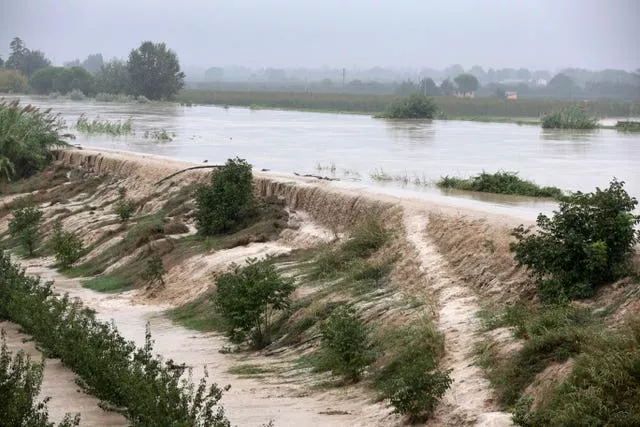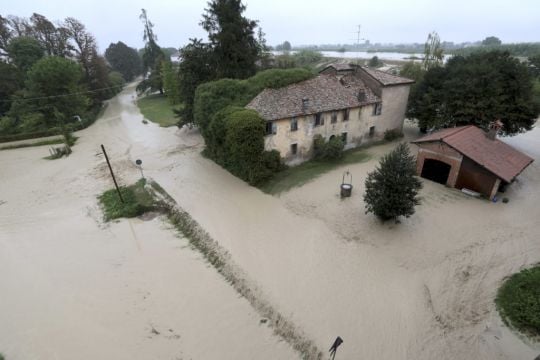A massive flood wave moving across central Europe is threatening new areas and raising concerns among residents and leaders.
It also prompted European Union head Ursula von der Leyen to plan a visit to the region on Thursday.
Heavy rains caused flooding and the evacuation of some 1,000 residents in the northern Italian region of Emilia-Romagna.

The death toll was rising in central Europe, as receding waters were revealing the huge scale of the destruction caused by exceptionally heavy rains that began a week ago.
Czech Interior Minister Vit Rakusan said the death toll had risen to five in the hard-hit north-east Czech Republic, and that eight were still missing.
That brings the death toll so far to 24 in the region.
Authorities have also reported seven deaths each in Poland and Romania, and five in Austria.
Authorities across the affected region have deployed their militaries.
In the two hardest-hit regions in the north-east Czech Republic, troops joined firefighters and other emergency officials to help residents with clean-up and recovery efforts.

Army helicopters have been used to distribute humanitarian help while soldiers are building temporary bridges after many were destroyed in the flooding.
Some 400 people remain in evacuation centres in the regional capital of Ostrava and are not able yet to return home.
In the country’s south-west near the border with Austria, the water level of the Luznice River has reached an extreme level but the evacuation of 1,000 people in the town of Veseli nad Luznici was not necessary for the moment, officials said.
Further to the south, in Hungary, flood waters continued to rise on Thursday as authorities shut down roadways, rail stations and ferries along the Danube River.
In the capital, Budapest, water spilled over the city’s lower quays and threatened to reach transport infrastructure like trams and metro lines. Some transport services were suspended.
Further upriver, in a region known as the Danube Bend, homes and restaurants near the riverbanks were inundated as officials and volunteers continued to place sandbags to reinforce levees.

Nearly 6,000 professionals, including members of Hungary’s water authority and military, have been mobilised to assist in flood preparations, Prime Minister Viktor Orban said in a news conference Thursday morning.
Inmates from prisons had also been mobilised to help fill sandbags, Mr Orban said.
The Danube rose nearly one metre (3.3 feet) in 24 hours, and by Thursday morning stood at 771 centimetres, approaching the 891-centimetre record set during major flooding in 2013.
In south-western Poland, the high water reached the city of Wroclaw and a stretched-out wave was expected to take many hours, even days to pass, exerting pressure on the embankments.
Concerned by the scope of the destruction and the need for immediate aid, Prime Minister Donald Tusk invited von der Leyen to Wroclaw to see the situation with her own eyes.
Government leaders from the Czech Republic, Slovakia and Austria are also to be present.
To the south in Italy, about a thousand residents were evacuated in the northern region of Emilia-Romagna after it was hit by torrential rains and severe flooding overnight, local media reported on Thursday.
Rivers flooded in three of the region’s provinces — Ravenna, Bologna and Faenza — as local mayors asked people to stay on the upper floors or leave their houses.
At least 800 residents in the Ravenna area and almost 200 in Bologna province spent the night in shelters, schools and sports centres as local rivers overflowed.
Trains were suspended and schools closed across the affected areas, and residents have been advised to avoid travel and work from home where possible.
Cleanup efforts were under way in Austria on Thursday, where flooding washed away roads and led to landslides and bridge damage. Firefighters and soldiers pumped water and mud out of houses and disposed of damaged furniture, broadcaster ORF quoted fire department spokesperson Klaus Stebal as saying.
The governor of Lower Austria province, Johanna Mikl-Leitner, said reconstruction was expected to take years, according to the Austria Press Agency.
The Vienna public transport company has had to pump almost a million litres (260,000 gallons) of water since last weekend.
Ten towns and areas were still inaccessible on Thursday, APA reported.







